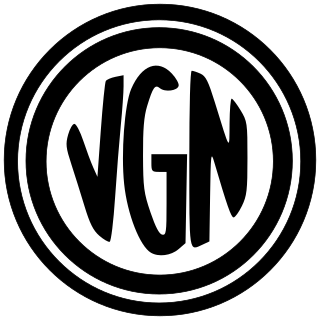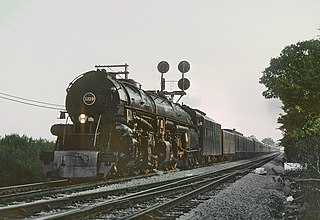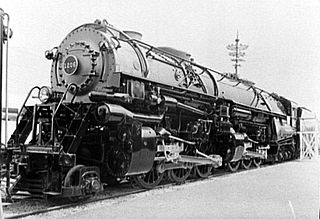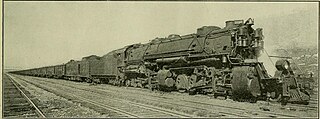
The Virginian Railway was a Class I railroad located in Virginia and West Virginia in the United States. The VGN was created to transport high quality "smokeless" bituminous coal from southern West Virginia to port at Hampton Roads.

The Norfolk and Western Railway, commonly called the N&W, was a US class I railroad, formed by more than 200 railroad mergers between 1838 and 1982. It was headquartered in Roanoke, Virginia, for most of its existence. Its motto was "Precision Transportation"; it had a variety of nicknames, including "King Coal" and "British Railway of America". In 1986, N&W merged with Southern Railway to form today's Norfolk Southern Railway.

A 2-8-8-2, in the Whyte notation for describing steam locomotive wheel arrangements, is an articulated locomotive with a two-wheel leading truck, two sets of eight driving wheels, and a two-wheel trailing truck. The equivalent UIC classification is, refined to Mallet locomotives, (1′D)D1′ 4v. These locomotives usually employ the Mallet principles of articulation—with the rear engine rigidly attached to the boiler and the front engine free to rotate—and compounding. The 2-8-8-2 was a design largely limited to American locomotive builders. The last 2-8-8-2 was retired in 1962 from the N&W's roster, two years past the ending of steam though steam was still used on steel mill lines and other railroads until 1983.

The Roanoke Shops is a railroad workshop and maintenance facility in Roanoke, Virginia. Between 1884 and 1953, the shops produced 447 steam locomotives, all for the Norfolk and Western Railway (N&W). The Roanoke Shops built the N&W's famous Big Three class steam locomotives; the 4-8-4 class J, the 2-6-6-4 class A, and the 2-8-8-2 class Y6. In late 1953, the Shops built their final steam locomotive, making it last standard gauge steam locomotive built for revenue service in the United States. In 2020, N&W's successor, Norfolk Southern, abandoned the Shops and Genesis Rail Services leased the property in July 2023.

The 2-6-6-6 is an articulated locomotive type with two leading wheels, two sets of six driving wheels and six trailing wheels. Only two classes of the 2-6-6-6 type were built. One was the "Allegheny" class, built by the Lima Locomotive Works. The name comes from the locomotive's first service with the Chesapeake and Ohio Railway beginning in 1941, where it was used to haul loaded coal trains over the Allegheny Mountains. The other was the "Blue Ridge" class for the Virginian Railway. These were some of the most powerful reciprocating steam locomotives ever built, at 7,500 hp, and one of the heaviest at 386 tons for the locomotive itself plus 215 tons for the loaded tender.

The Powhatan Arrow was a named flagship passenger train operated by the Norfolk and Western Railway (N&W) in the United States. Debuting on April 28, 1946, the daily westbound No. 25 and the eastbound No. 26 connected Norfolk, Virginia, and Cincinnati, Ohio, covering 676 miles (1,088 km) in about 15 hours and 45 minutes behind streamlined 4-8-4 class J steam locomotives. In late 1949, N&W re-equipped the Powhatan Arrow consist with new lightweight passenger cars, dining cars, and observation cars from the Pullman-Standard Company. It was advertised as the "most beautiful train in the east."
The Norfolk and Western J class was a class of 14 4-8-4 "Northern" streamlined steam locomotives built by the Norfolk and Western Railway (N&W) at its Roanoke Shops in Roanoke, Virginia, between 1941 and 1950. The most powerful 4-8-4 locomotives ever produced, the J class were part of the N&W's "Big Three" that represented the pinnacle of steam technology.

The Virginia Museum of Transportation (VMT) is a museum in Downtown Roanoke, Virginia, that is devoted to the topic of transportation.

Norfolk and Western 475 is a M class 4-8-0 "Twelve-wheeler" type steam locomotive built in June 1906 by the Baldwin Locomotive Works as part of the Norfolk and Western Railway's (N&W) first order of M class numbered 375–499. It was first assigned to haul freight trains on the N&W mainline before being reassigned to branch line duties on the Blacksburg Branch in the 1920s.

Norfolk and Western 1218 is a preserved four-cylinder simple articulated 2-6-6-4 steam locomotive, built in June 1943 by the Norfolk and Western's (N&W) Roanoke Shops in Roanoke, Virginia as part of the N&W's class "A" fleet of fast freight locomotives. It was retired from regular revenue service in July 1959, and was later restored by Norfolk Southern for excursion service for their steam program, pulling excursions throughout the eastern United States from 1987 to 1991. It is currently on display at the Virginia Museum of Transportation in Roanoke, Virginia.

Norfolk and Western 2156 is a preserved Y6a class 2-8-8-2 compound Mallet steam locomotive. The Norfolk and Western Railway (N&W) built it in 1942 at its own Shops in Roanoke, Virginia as the second member of the N&W's Y6a class. No. 2156 and its class are considered to be the world's strongest-pulling extant steam locomotive to ever be built.

Norfolk and Western 611, also known as the "Spirit of Roanoke" and the "Queen of Steam", is the only surviving example of Norfolk and Western's (N&W) class J 4-8-4 type "Northern" streamlined steam locomotives. Built in May 1950 at N&W's Roanoke Shops in Roanoke, Virginia, it was one of the last mainline passenger steam locomotives built in the United States and represents a pinnacle of American steam locomotive technology.

The N&W LC-1 was a class of boxcab electric locomotives built by Baldwin-Westinghouse for the Norfolk and Western Railway. The locomotives were part of an electrification project undertaken by the N&W to improve traffic conditions on the Elkhorn grade in its Bluefield Division. Baldwin-Westinghouse delivered 12 twin-unit boxcabs in 1914–1915. N&W scrapped them in 1950 when it discontinued electric operations.

The Elkhorn Grade Electrification was a project undertaken by Westinghouse in 1913–1915 to electrify a 27-mile (43 km) section of the Norfolk and Western Railway's Bluefield Division in Virginia and West Virginia. Electrification was extended in the 1920s, reaching 52 miles (84 km) before the N&W abandoned it in 1950 when a new Elkhorn tunnel was built with an easier grade and a double track mainline.

The Atlantic Coast Line R-1 was a class of 12 4-8-4 Northern type steam locomotives built by Baldwin Locomotive Works (BLW) in 1938 and operated by the Atlantic Coast Line Railroad until the early 1950s. They were immediately assigned to passenger service but eventually saw service pulling freight.

The Norfolk and Western A was a class of 43 2-6-6-4 simple articulated steam locomotives built by the railroad's own Roanoke Shops between 1936 and 1950 and operated until the late 1950s. The locomotives hauled fast and heavy freight trains for the railroad and only one has been preserved, No. 1218.

The Chesapeake and Ohio class H-8 was a class of 60 simple articulated 2-6-6-6 steam locomotives built by the Lima Locomotive Works in Lima, Ohio between 1941 and 1948, operating until the mid 1950s. The locomotives were among the most powerful steam locomotives ever built and hauled fast, heavy freight trains for the railroad. Only two units were preserved; Nos. 1601 and 1604.

Norfolk and Western 2174 was a Y6b class 2-8-8-2 compound Mallet steam locomotive, built by the Norfolk and Western Railway's (N&W) own Roanoke Shops, in 1948. No. 2174 and the other Y6bs were notably some of the most powerful steam locomotives ever built, being able to pull heavy freight and coal trains, unassisted. They were also some of the last steam locomotives ever built in the United States.

Norfolk and Western 2050 is a Y3a class 2-8-8-2 Compound Mallet steam locomotive built in March 1923 by the American Locomotive Company's (ALCO) Richmond, Virginia Works for the Norfolk and Western Railway (N&W). The locomotive primarily helped haul the N&W's freight and coal trains, but by the end of the 1950s, it was relegated as a hump yard switcher.

The Norfolk and Western Y3 and Y3a classes were classes of 2-8-8-2 "Mallet" articulated steam locomotives, with a total of 80 locomotives built for the Norfolk and Western Railway between 1919 and 1923.



















